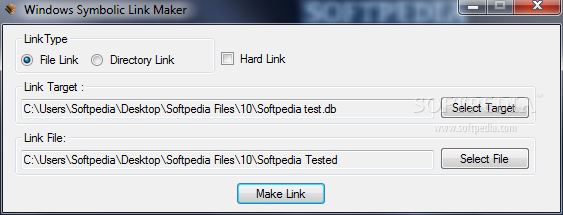
Since this setting is set to ‘Administrators’ by default, you should only make sure no one had changed it.
#SYMBOLIC LINKER WIN HOW TO#
Hyper-V: Not defined, NT VIRTUAL MACHINE\Virtual Machines HOW TO CONFIGURE:
#SYMBOLIC LINKER WIN WINDOWS#
The default value of this setting in Windows servers 2008, 2012, 2016, and 2019 is ‘administrators’. Setting ‘Create Symbolic Links’ to administrators only is important.Įnabling ‘Strengthen default permissions of internal system objects’ is critical. In most cases there will be no impact because this is the default configuration, however, on Windows Servers with the Hyper-V server role installed this user right should also be granted to the special group “Virtual Machines” otherwise you will not be able to create new virtual machines.ĭomain Controller: LDAP Server Signing Requirements

It will allow users who are not administrators to read symbolic links but not to modify any that they did not create. This policy setting determines the strength of the default discretionary access control list (DACL) for objects such as symbolic links. In addition, you can use ‘fsutil’ command to control what kind of symbolic links can be created on a computer.Īnother security measure you should take is to make sure that ‘System objects: Strengthen default permissions of internal system objects’ is enabled. Only allow trusted administrators to use this feature. The attacker may eventually be able to control the actions of the targeted machine or to get access to information, leveraging the target’s permissions.ĭo not assign standard users with the right to Create Symbolic Links. This will allow the attacker to feed the target machine with malformed input, or to make it process different information.

By default, only Administrators can create symbolic links. For this reason, the privilege for creating symbolic links should only be assigned to trusted users. Symbolic links can potentially expose security vulnerabilities in applications that are not designed to use them. This policy determines who can create symbolic links. These links can also refer to NTFS file system objects in Windows Vista. Windows Symbolic Links operate just like UNIX links. Symbolic Links are designed to aid in the connectivity with UNIX operating systems (OS) by allowing migration and application compatibility between Windows and UNIX OS. The difference between this kind of link and a shortcut is that a shortcut could only work from within the Windows shell.

Symbolic links (or Soft Links) are pointers to another file system object, which can be a file, folder, shortcut, or a different symbolic link. How to change Create Symbolic Links configuration settings. CalCom’s recommended value for this policy.ĩ. The potential impact of changing this configuration settingĨ. The potential vulnerability in Symbolic Links.ĥ. Create Symbolic Links policy description.ģ. Learn how CalCom Hardening Solution can help you harden your entire infrastructure fast, and without damaging production.Ģ. Therefore, the best approach to this project is using automation tools to help you implement a robust policy, such as the CIS Benchmarks. If you’re reading this article, you probably know it. Server hardening can be a painful procedure. Securing the configuration of this setting is part of a greater task- server hardening. The Ensure Create Symbolic Link in Windows is set to Administrators (DC only) rule is part of the CIS Benchmarks recommended policy. This Policy Expert post will discuss the recommended setting for Symbolic Links in your servers, since as much as they are useful, Symbolic Links can also be used maliciously to gain access and control in your network.


 0 kommentar(er)
0 kommentar(er)
